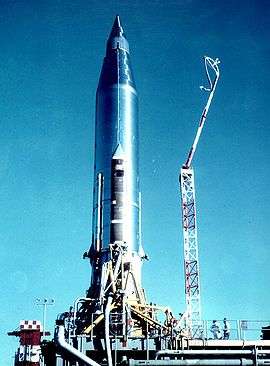SCORE (satellite)
| Mission type | Communications |
|---|---|
| Operator | DARPA |
| Harvard designation | 1958 Zeta 1 |
| SATCAT № | 10 |
| Spacecraft properties | |
| Launch mass | 3,980 kilograms (8,770 lb) |
| Start of mission | |
| Launch date | 18 December 1958, 23:02:00 UTC |
| Rocket | Atlas-B 10B |
| Launch site | Cape Canaveral LC-11 |
| End of mission | |
| Decay date | 21 January 1959 |
| Orbital parameters | |
| Reference system | Geocentric |
| Regime | Low Earth |
| Semi-major axis | 7,832.2 kilometers (4,866.7 mi) |
| Eccentricity | 0.08999 |
| Perigee | 185 kilometers (115 mi) |
| Apogee | 1,484 kilometers (922 mi) |
| Inclination | 32.3° |
| Period | 101.4 minutes |

Project SCORE (Signal Communications by Orbiting Relay Equipment) was the world’s first communications satellite. Launched aboard an American Atlas rocket on December 18, 1958, SCORE provided a first test of a communications relay system in space, as well as the first successful use of the Atlas as a launch vehicle. It captured world attention by broadcasting a Christmas message via short wave radio from U.S. President Dwight D. Eisenhower through an on-board tape recorder.[1] The satellite was popularly dubbed "The Talking Atlas". SCORE, as a geopolitical strategy, placed the United States at an even technological par with the Soviet Union as a highly functional response to the Sputnik 1 and Sputnik 2 satellites.
Background
The six-month effort was the first endeavor of the then-new Advanced Research Projects Agency (ARPA) headed by Roy Johnson, and proved that a small, highly focused and versatile research group with appropriate resources was an ideal method to achieve the scientific and technological advances necessary to succeed in the emerging global space race.[2]
SCORE's technical objectives were two-fold. In addition to showing that an Atlas missile, a hundred times more massive than any previous US satellite, could be put into orbit, the project demonstrated the feasibility of transmitting messages through the upper atmosphere from one ground station to one or more ground stations. The result of the project, which used both real-time and store and forward techniques, was a major scientific breakthrough which proved that active communications satellites could provide a means of transmitting messages from one point to any other on Earth.[3]
Mission
The SCORE communications package was designed and built by Kenneth Masterman-Smith, a military communication research engineer, along with other personnel with the U.S. Army Signal Research and Development Laboratory (SRDL) at Fort Monmouth, New Jersey.[4] The overall project was conducted in such secrecy that only 88 people were aware of its existence. Before the date of the SCORE launch, 53 of the 88 people had been told the project had been canceled and they were not to mention to anyone that it had ever existed. That left only 35 people who knew of the mission of Atlas 10B with the rest of the engineering crew, including the launch crew, under the impression that they were working solely on a test launch of the rocket.[5]:236 The night before launch, however, Rear Adm, John E. Clark, deputy director of ARPA, was asked at a news conference whether he could deny that Eisenhower's voice was on the recorder. He replied, "No," and news reports that day suggested the voice might well be the president's.[6]
The payload weighed 68 kg (150 pounds), and was built into the fairing pods of the Atlas missile. Combined weight of the total on-orbit package was 3969 kg (8750 pounds). SCORE was launched into a 183 km by 1,481 km (114 mile by 920 mile) orbit from LC-11 at Cape Canaveral Missile Test Annex, Florida inclined 32.3 degrees, with a period of 101.5 minutes. Its batteries lasted 12 days and it reentered the atmosphere on 21 January 1959.[7] The communications repeater installed on the missile would receive a signal, amplify it, and then retransmit it. Two redundant sets of equipment were mounted in the nose of the SCORE missile. Four antennas were mounted flush with the missile surface, two for transmission and two for reception. SCORE's other equipment included two tape recorders, each with a four-minute capacity. Any of four ground stations in the southern United States could command the satellite into playback mode to transmit the stored message or into record mode to receive and store a new message. These redundancies proved invaluable as one of the tape recorders malfunctioned and was rendered inoperable during the 12-day mission.[1]
The first transmitted message from space to Earth was:
"This is the President of the United States speaking. Through the marvels of scientific advance, my voice is coming to you from a satellite circling in outer space. My message is a simple one: Through this unique means I convey to you and to all mankind, America's wish for peace on Earth and goodwill toward men everywhere."[1]
The broadcast signal for Eisenhower's greeting was fairly weak, and only very sensitive radio receivers were able to detect it. Most Americans heard the message as it was rebroadcast on commercial news programs.[5]:243
See also
References
- 1 2 3 "SCORE (Signal Communications by Orbiting Relay Equipment)". GlobalSecurity.org. 20 September 2006. Retrieved 2010-12-16.
- ↑ "Darpa". The Froehlich/Kent Encyclopedia of Telecommunications. CRC Press. 1992. pp. 75–77. ISBN 0-8247-2903-X.
- ↑ "Project Score". Patterson Army Health Clinic. Retrieved 2010-12-16.
- ↑ Masterman-Smith, Michael. "12-18-1958 First Communication Satellite". Engineering Pathway. Retrieved 2010-12-16.
- 1 2 D'Antonio, Michael (2008). A Ball, a Dog, and a Monkey: 1957 — The Space Race Begins. Simon and Schuster. ISBN 0-7432-9432-7.
- ↑ "Eisenhower's Voice May Be Beamed to Earth Stations from Outer Space" UPI (December 17, 1958) Rome News-Tribune", p. 1
- ↑ Encyclopedia Astronautica - Atlas B